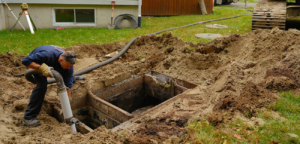A septic tank digests organic waste, separating floatable materials (such as oils and grease) from wastewater. The pre-processed effluent then flows to a drain field or leach field, where it is filtered by soil.
The best way to avoid clogs is to limit septic system use and not flush any non-degradable items, such as feminine hygiene products, condoms, cigarette butts, dental floss, and pet waste. Also, plant trees and shrubs far away from the drain field. Contact Septic Tank Armadale now!

The septic tank is the main component of an onsite sewage waste management system. Also known as a decentralized treatment, cluster system, on-lot sewer, or private septic system, these systems handle human biowaste’s storage, handling, and breakdown that flows out of sinks, toilets, showers, and washing machines.
The system links to a drain field, which is a series of perforated pipes buried in gravel trenches that filter and distribute the wastewater. This process is incredibly efficient and does not pollute the waterways or groundwater. However, it does require proper maintenance from homeowners.
A home’s septic system requires a permit from the local health department to install and operate. The installer must also obtain a soil test to make sure the property can support a septic system and comply with building codes. If a company does not comply with all local laws and requirements, it could face serious legal complications. Choosing an experienced, professional installer can help avoid such problems.
When you’re ready to buy a property with a septic tank, you should request the permit numbers from the county and contact a septic company for an inspection and estimate. When selecting an installer, look for a reputable company with a good reputation in your community and the right equipment to perform the work correctly. Credible septic companies carry liability insurance, which protects their employees and clients in the event of an accident on site.
Septic tanks are available in a variety of sizes to meet the needs of homes and businesses. The size of the septic tank will depend on the number of people living in the house, how much water is used daily, and whether any major appliances are connected to the septic system.
Most septic tanks are made from concrete or fiberglass, although some are now constructed of plastic. The tank material has a significant impact on upfront and long-term costs. Concrete tanks are highly durable and can last for decades, but they’re heavy and costly to install. Fiberglass tanks are lightweight and cheaper, but they may not be as strong or durable as concrete.
Septic Tank Repair
Septic systems are complex and require maintenance to prevent clogs, system failure, and back-ups of sewage into the home. A septic tank that fails to meet its service capacity will result in wastewater and sewage backing up into plumbing fixtures, contaminated groundwater, surface water and your yard with foul odors. Taking steps to maintain your septic system can extend its lifespan, prevent expensive repairs, and protect the health of your family and pets.
The septic tank is a buried, water-tight container usually constructed of concrete or fiberglass. It holds the household waste until it is emptied into the drain field. Wastewater enters the tank through the sewer line from your house and passes through a series of partitions and a T-shaped outlet. Solids settle at the bottom of the tank forming sludge and oil and grease floats to the top forming scum. The liquid waste (effluent) exits the tank through an effluent filter or outlet baffle and travels into the drain field for absorption.
If a septic tank reaches or exceeds its service capacity, it must be pumped to prevent the waste from overflowing into the drainage field and contaminating groundwater and surface water with bacteria and viruses. The septic tank should also be inspected to ensure that the baffles are working properly.
Replacing diseased baffles can improve the efficiency of a septic tank by ensuring that the flow of solids and liquid is separated effectively. A faulty baffle could cause the wastewater to flow directly into the drain field, where it would not be absorbed and could lead to septic system failure.
An inlet baffle clog can cause wastewater to enter the household plumbing, often resulting in a toilet that is constantly flushing or a backed-up sewer line. A septic tank technician can determine the source of the clog by looking at the effluent filter or inlet baffle. Getting your tank pumped and having the inlet baffle or effluent filter cleaned can eliminate this problem.
A septic tank should be located away from buildings and structures, which can damage or puncture the septic tank or its lid. It is also important to avoid parking or driving vehicles and machinery over the tank or its drain field, as this can damage the piping or reduce the soil porosity that allows the absorption field to work properly.
Septic Tank Pumping
When a homeowner hires a company to pump their septic tank, the technician will likely arrive in a large truck equipped with a giant tank and a suction hose. The septic waste is “pumped” into the truck where it is then transported to a sewage processing facility to be safely handled.
A septic system requires a regular schedule of pumping and maintenance to ensure that the solid waste is properly digested and removed from the drain field and home. The frequency of pumping depends on the size and usage of the septic tank and how much solid waste is generated in a household. In general, septic tanks need to be pumped every 2 years.
In order to keep the septic tank functioning at its best, homeowners should avoid flushing non-biodegradable materials down the toilet. Some of the most common items that should not be flushed include cigarette butts, cotton swabs and other hygiene products, menstrual hygiene products and condoms. It is also a good idea to minimize the use of garbage disposal units since food waste can build up in the septic tank and clog the drainfield.
The solids in a septic tank settle to the bottom and form a sludge layer. The more solids in the septic tank, the faster it will fill and need to be pumped. Grease and other lightweight materials float to the top of the tank and form a scum layer. When the septic tank is full, sludge and scum will flow out of the septic tank into the drainfield area through a T-shaped outlet. This septage enters the groundwater, where it is filtered through soil microbes and evaporates.
A septic tank should be pumped when the sludge is within six inches of the bottom of the outlet or when the scum layer is more than 25% of the liquid depth in the tank. The septic tank should also be pumped when there is a foul odor coming from the septic system. This is because septic tank gases are escaping and can be hazardous to health.
The septic tank should also be inspected and cleaned on a regular basis by a licensed professional. This includes checking for cracks or damage to the tank and inspecting the inlet and outlet pipes and baffles to make sure they are in working condition. If any problems are spotted, the professional may recommend additional tank repairs or drainfield restoration.
Septic Tank Maintenance
A septic tank is a buried, water-tight container usually made from concrete, fiberglass or polyethylene. Wastewater from your home flows into the septic tank through pipes, where it is treated by bacteria and other organisms that break down the solid waste. Heavy solids sink to the bottom of the tank, forming sludge, while lighter materials float to the top, becoming scum. A T-shaped outlet prevents sludge and scum from leaving the septic tank, and only liquid wastewater (effluent) is allowed to exit through perforated pipes into the drain field.
The soil in the drain field acts as a natural filter, getting rid of more bacteria and other contaminants. A properly working septic system prevents human waste, including viruses and bacteria, from reaching groundwater or surface water.
What you put down your drains can affect how well your septic system works. You should never flush cat litter, coffee grounds, diapers, towelettes (even the ‘flushable’ kind), feminine hygiene products, hair, grease, oils, household cleaners, paints or thinners, medicines or pet waste down your toilets. These can clog your toilets and cause the septic tank to overflow, leading to costly repairs.
It’s important to have your septic tank inspected and pumped regularly, and to follow maintenance guidelines to keep it working properly. You should also map out your septic system or mark its components with permanent stakes, so you can avoid damaging it when doing yard work or other chores. Avoid parking or building structures over the drain field area, as this can compact the soil and restrict wastewater flow.
You should also make sure to avoid using chemical drain openers, which can disrupt the balance of bacteria inside your septic tank and contaminate the environment. Similarly, you should never add organic matter to the septic system, such as tree stumps and leaves, which can reduce its efficiency and lead to overflows and clogs. You should also avoid using excessive amounts of water at one time, as this can overwork the septic system and flood the drain field.
